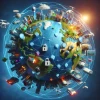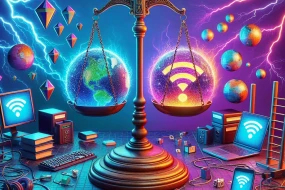
In a world increasingly defined by digital connectivity, having access to the internet is no longer a luxury but a necessity. Yet, as we stride deeper into the digital age, a stark divide persists. The digital divide is not just about who can binge-watch their favorite shows or shop online; it’s about who has access to education, employment opportunities, and vital services. This divide isn't just a chasm between developed and developing nations but a fracture running through communities worldwide. Let’s explore how this digital divide shapes our societies, the barriers it erects, and the pathways to a more connected future.
The Anatomy of the Digital Divide
To understand the digital divide, we must first dissect its anatomy. At its core, the digital divide refers to the gap between individuals who have access to modern information and communication technology and those who do not. This gap is influenced by various factors, including socioeconomic status, geographical location, age, and education level.
1) **Socioeconomic Barriers**: Wealthier individuals and communities often have better access to high-speed internet and the latest technologies. In contrast, those from lower-income backgrounds may find themselves priced out of connectivity, unable to afford devices or monthly service fees.
2) **Geographical Disparities**: Urban areas typically enjoy robust internet infrastructure, while rural communities lag behind. The cost of laying cables and building infrastructure in sparsely populated areas is high, discouraging investment.
3) **Educational Divide**: Education also plays a crucial role. Those with higher educational attainment are more likely to use the internet effectively and access online resources. Conversely, limited digital literacy can create a barrier even when access is available.
The Impact of the Digital Divide on Society
The consequences of the digital divide extend far beyond the inability to stream movies or play online games. It affects education, employment, healthcare, and social inclusion.
1) **Education**: The pandemic highlighted the importance of digital access in education. Students without reliable internet struggled to participate in remote learning, widening educational disparities.
2) **Employment**: Many jobs now require digital skills or remote work capabilities. Those without access to technology are at a disadvantage in the job market, exacerbating economic inequality.
3) **Healthcare**: Telemedicine has become a crucial component of healthcare delivery. However, individuals without internet access cannot benefit from virtual consultations, impacting their health outcomes.
4) **Social Inclusion**: The internet is a powerful tool for social inclusion, allowing people to connect with others, access support networks, and participate in civic activities. Without it, marginalized groups risk further isolation.
Bridging the Gap: Initiatives and Solutions
Efforts to bridge the digital divide must be multifaceted, involving governments, private companies, and non-profit organizations.
1) **Government Initiatives**: Many governments are investing in expanding broadband infrastructure, particularly in rural and underserved areas. Subsidies and grants can make internet access more affordable for low-income families.
2) **Private Sector Involvement**: Companies like Google and Facebook have launched initiatives to provide internet access in remote areas, using technologies like high-altitude balloons and drones.
3) **Educational Programs**: Improving digital literacy through educational programs can empower individuals to make the most of internet access. Schools and libraries play a vital role in providing resources and training.
4) **Community Efforts**: Community-based organizations can tailor solutions to local needs, offering support and resources to bridge the divide in practical, culturally appropriate ways.
Common Missteps in Addressing the Digital Divide
While many efforts are underway to close the digital gap, some approaches can inadvertently widen it. Here are common mistakes to avoid:
1) **One-Size-Fits-All Solutions**: Assuming a uniform solution can address diverse needs often results in ineffective programs. Tailored approaches are crucial.
2) **Ignoring Digital Literacy**: Providing access without education on how to use digital tools limits the benefits. Digital literacy programs are essential complements to access initiatives.
3) **Overlooking Affordability**: Infrastructure is only part of the equation. Without addressing the cost barrier, many will remain disconnected despite available services.
4) **Neglecting Local Contexts**: Successful initiatives consider cultural and local contexts. Community involvement is key to understanding and addressing unique challenges.
A Future of Connectivity: Vision and Challenges
The vision of a fully connected world is enticing, promising equal opportunities and access to information for all. However, achieving this vision requires overcoming significant hurdles.
1) **Technological Advancements**: Continued innovation in technology, such as 5G and satellite internet, could help bridge the gap, but only if combined with accessibility and affordability strategies.
2) **Policy and Regulation**: Effective policies must balance encouraging innovation with ensuring equitable access. Governments and regulatory bodies play a critical role.
3) **Sustainable Investment**: Long-term solutions require sustainable investment from both public and private sectors. Short-term fixes will not suffice in closing the digital divide permanently.
4) **Global Collaboration**: Bridging the digital divide is a global challenge that requires international cooperation. Sharing knowledge, resources, and strategies can accelerate progress.































